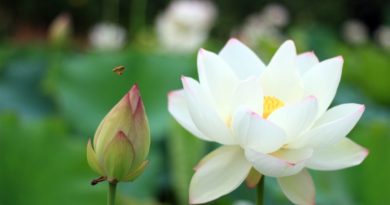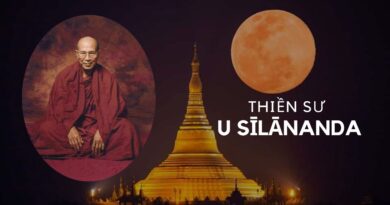VIPASSANA MEDITATION – CHAPTER 1: HAPPINESS THROUGH RIGHT UNDERSTANDING
MAIN CONTENT
VIPASSANA MEDITATION – CHAPTER 1: HAPPINESS THROUGH RIGHT UNDERSTANDING
Part 1 – The Cause Of Suffering
The Lord Buddha found out the cause of suffering (dukkha). According to his teachings, everything arises dependent on conditions. Everything in the world has its cause; nothing arises without a cause. When the Buddha wanted to get rid of suffering (dukkha), he had to find out the cause. When the cause had been eradicated, there will not be any effect. When the omniscient Buddha became enlightened, he discovered that the cause of suffering is attachment (tanha). The word tanha means greed, lust, desire, craving and the like. Buddhist scholars have translated tanha into attachment so that it covers all forms of desire. So in English, we use the word attachment for tanha.
Tanha or attachment is the cause of suffering. When there is tanha there is dukkha (suffering). When a man can eliminate tanha, he is sure to get rid of dukkha. This tanha also arises dependent on a cause. Without a cause, tanha will not arise. Tanha is a mental state and a process of mentality which is conditioned. The Omniscient Buddha discovered that the cause of attachment (tanha) is wrong view, i.e. the false view of a soul, a self, an I or a you a personality or an individuality known as sakkaya ditthi or atta ditthi. So thissakkaya ditthi or atta ditthi is the cause of tanha which causes dukkha. Then what is the cause of this false view (sakkaya ditthi or atta ditthi) ?
The Omniscient Buddha pointed out that ignorance (moha or avijja in Pali) of the natural processes of mentality and physicality is the cause of the false view of a soul or a self. Thus by realization or right understanding of this dual process in its true nature, we can exterminate ignorance. Then we come to know the law of Cause and Effect. We can summarize the chain of cause and effect like this: Ignorance is the cause, false view (sakkaya ditthi or atta ditthi) is the effect. False view is the cause, attachment is the effect. Attachment is the cause, suffering is the effect.
Then what we come to know is : if mental and physical processes are rightly understood, that right understanding will do away with ignorance. When ignorance has been eradicated, then there will not be any false view of a soul, a self, a person or a being. When this false view has been destroyed, there will not arise any suffering. Then we reach a stage in which all kinds of suffering cease to exit – the cessation of suffering (Nirodha sacca) is attained.
Part 2 – The Cause Of False View
We should consider how ignorance of the mind body processes causes false view of a soul or a self, a person or a being, an I or you; and how this false view causes attachment to arise. It is because we do not rightly understand this dual process in its true nature that we consider it as as person or a being, a soul or a self. Then, that person, that being, that I or that you has a desire to be rich, or to be a king, a queen or a president, a prime minister or a millionaire. This desire to be a queen or a president etc., is attachment. It arises through the false idea of a person or a being, a soul or a self, an I or you
If we want to exterminate this desire or attachment, then we must destroy its cause. What is the cause? The cause of desire or attachment is, as I have explained earlier, the false view or false concept of a person or a being, a soul or a self. So, when the false view has been destroyed, there will not arise any attachment to become a rich man, a king, a president or so on. The desire to be, to get, to have something arises through false view or the false concept of a person or being, an Im or you. When that desire or attachment arises in us, it brings about all kinds of suffering.
When we attached to our house, a non living thing, we are worried about our house. If our house is on fire, we feel sad. Sadness is one of the main kind of suffering. That suffering is caused by our attachment to our house. Then again, when we attached to our relatives, to our friends, to our children, or to our parents; this attachment also causes us to suffer. When we are attached to our children, we worry about our childrens health, education and so on. If our children fail their examinations, we are worried, we feel sorry and sad. This suffering is mental suffering or mental dukkha, and is caused by attachment to our children. So, attachment (tanha) is the cause of suffering. Where does this attachment come from? This attachment comes from the false conception of bodily and mental processes as person or a being, a soul or a self, an I or a you. When this concept of personality and individuality has been destroyed, there will not be any attachment. Where there is no attachment, there will not be any suffering.
Part 3 – See It As It Is
The Omniscient Buddha pointed out that by being mindful of this dual process as it really is, we are able to rightly understand its really intrinsic nature. When we want to understand something as it really is, we should observe it, watch it, be mindful of it as it really occurs without analyzing it, without logical reasoning, without philosophical thinking and without pre conceptions. We should be very attentive and mindful of it as it really is.
For example – look at a watch. When we do not observe a watch attentively and carefully we cannot understand it as it is. When we observe it very attentively and closely, then we see its brand, its design and the figures on it. We come to understand that this is a watch; its brand name is Seiko; it has an international time chart etc. However if we do not observe it as it is, if our observation is combined with such preconceived ideas as, “I have seen such a watch before and its brand name is Omega”, then, as soon as we see this watch, we will take it to be an Omega. Why? Because we do not observe it attentively and closely. We have used the preconceived idea when we saw it, so the preconceived ideas lead us to the wrong conclusion regarding the watch. If we put the preconceived idea aside and just observe it attentively and closely, we will understand it as it is – this is a Seiko, it is made in Japan, it also has an international time chart. We will understand it as it is because we had put aside our preconceived idea of “Omega” when we observed it.
In the same way, when we want to rightly understand the mind body processes in their true nature or as they really are, we must not analyze them or think about them. We must not reason or use any intellectual knowledge, or any preconceived idea. We must leave them aside and pay bare attention to what is happening to the mind body phenomena as they really are. The, we can see our mind body processes as they really are. When our body feels hot, we should note that feeling of heat as heat. When the body feels cold, we should note it as cold. When we feel pain, we should note it as pain. When we feel happy, we should note that happiness. When we feel angry, we should note that anger as anger. When we feel sorrow, we should be mindful of it as sorrow. When we feel sad or disappointed, we should be aware of our emotional state of sadness or disappointment as it is.
Each and every mental and physical process must be observed as it really occurs so that we can rightly understand it in its true nature. That right understanding will lead us to remove ignorance. When ignorance has been removed, then we do not take the mind body processes to be a person, a being, a soul or a self. If we take these mind body processes to be just natural processes, then there will not arise any attachment. When the attachment has been destroyed, we are free from all kinds of suffering and have attained the cessation of suffering. So, mindfulness of mind body processes in their nature is the way leading to the cessation of suffering. That is way the Omniscient Buddha delivered a discourse on “The Four Foundation of Mindfulness”.
In this discourse, the Omniscient Buddha teaches us to be mindful of mental and physical phenomena as they really are. There are many ways by which we have to be mindful of the mind body processes but they can be summarized as follows:
- Mindfulness of bodily process (Kayanupassana Satipatthana)
- Mindfulness of feeling or sensation (Vedananupassana Satipatthana)
- Mindfulness of Consciousness (Cittanupassana Satipatthana)
- Mindfulness of mind objects (Dhammanupassana Satipatthana)
Part 4 – Choiceless Awareness
When we are mindful of our mind body process, we do not need to choose any mental or physical process as the object of our meditation. The mind will choose the object by itself. If we choose any mental or physical process as the object of meditation, it means we are attached to it. During meditation, the noting mind or the observing mind will choose the object by itself; perhaps a feeling of happiness for our success, or a painful sensation, or the abdominal movement. Though we try to focus the mind on the abdominal movement, the mind does not stay with it if the pain is more distinct or more prominent. The noting mind will go to the pain and observe it because the more distinct feeling takes the mind toward it very strongly. So we need to choose the object but should observe the object that the mind chooses. When pain disappear through attentive and close awareness, the mind will choose another object which is more distinct. If the itchy sensation on the back is more distinct or more pronounced than the abdominal movement, the mind will go to the feeling of itchiness and observe it as itching, itching, itching. When the itchy sensation has disappeared by means of strong mindfulness and deep concentration, the mind will choose (for example) the abdominal movement as its object because it is more distinct than the other objects. If happiness is more distinct than the abdominal object, the mind will choose happiness as its object and observe it as happy, happy, happy. So the principle of Vipassana meditation or mindfulness meditation is to observe, to watch, or to be mindful of all mental or physical phenomena as they really are. This mindfulness meditation is not only very simple and easy, but also very effective in achieving our goal – the cessation of suffering.
When we are taking food, we should be aware of every action, every activity involved in the act of eating. When we stretch out our arm, we must be aware of the movement of stretching. When the hand touches the spoon or the rice, the touching sensation must be observed. When we hold the spoon, the sensation of holding must be observed. When we dip the spoon into the curry, that dipping movement must be observed. When we scoop curry with the spoon, that movement must be observed. In this way, each and every action involved in the act of eating must be observed as it is because every physical process must be thoroughly realized so as to remove ignorance which is the cause of false view. In the same way, when we are taking a bath; while we are working in the office or at home, we must be aware of all the actions or movements involved. When practising walking meditation in a retreat, the movements of the foot such as the lifting movement, the pushing movement and the dropping movement must be closely and precisely observed as they really are.
Part 5 – Labelling
We may need labelling or naming when we are mindful of any object. When we lift our foot to walk, we should label it as lifting. When we push it forward, we should label it as pushing. When we drop it, we should label is dropping. In this way lifting, pushing, dropping; lifting, pushing, dropping. Labelling or naming can lead the mind to the object of the meditation closely and precisely. It is also very helpful for a meditator to focus his mind on the object of meditation. However, there may be some meditators who need not label or name the object of meditation. Instead, they just observe it. They should just observe the movement of the foot – from the very beginning of the lifting movement up to the end of the dropping movement. The mind must follow the movement of the foot very closely as it is, without thinking or analyzing. In this way, one can develop concentration more deeply that ever.
At the beginning of the practice, the mind wanders very often. Whenever the mind wanders, you should follow the mind and observe it. If you are thinking about your family affairs, that thought must be observed as it is, making a mental note, thinking, thinking, thinking. After the initial thought has disappeared, you should resume your walking and noting as usual – lifting, pushing, dropping.
Part 6 – Samatha And Vipassana
Here, we should know the difference between Samatha meditation and Vipassana meditation. Samantha means concentration , calmness, tranquility. When the mind is deeply concentrated on the object of meditation, the mind become calm and tranquil. The purpose of Samatha meditation is to attain deep concentration of the mind on a single object. So, the result of Samatha meditation is the attainment of deep concentration such as absorption (appana samadhi, jhana) or access concentration (upacara samadhi). When the mind is deeply concentrated on the object of meditation, all the defilements such as lust, greed, hatred, desire, conceit, ignorance and so on are kept away from the mind which is absorbed in the object. When the mind is free from all the defilements or hindrances, we feel calm, tranquil, happy and peaceful. The results of the Samatha meditation, therefore, is some degree of happiness through the attainment of deep concentration such as Absorption (appana samadhi, Jhana) or access concentration (upacara samadhi) but it does not enable us to rightly understand the mental and physical phenomena as they really are.
A Samatha meditator has to make some device or kasina as the object of meditation. For instance, to make a colour kasina, he has to make a red circle on the wall about two feet from the floor in accordance with the Visuddhimagga commentary. He must make the red circle about the size of a plate and the colour must be of pure red, even and smooth. When the device has been made, then he has to sit on the floor about two feet from the wall, look at the red circle and concentrate on it. Should the mind wander, he must not follow the mind but he must bring it to the object of meditation, i.e., the red circle. He must focus the mind on the red circle and and observe it as red, red, red. This is the way of Samatha meditation in brief.
As for Vipassana meditation, the purpose is to attain the cessation of suffering through rightly understanding mental and physical processes in their true nature. For this, we need some degree of concentration. This concentration can be attained through constant and uninterrupted mindfulness of the mind body process. Thus, we have a variety of objects of meditation: happiness is an object of meditation and so is anger, sorrow, painful sensation, stiffness, numbness and so on. Any mental or physical process can be the object of meditation.
The purpose and the results of Samatha and Vipassana meditation are different, as are the methods.
We should go back to what I explained earlier. When we walk, we observe the movement of the foot – the lifting, pushing and dropping. At the beginning of the practice, our mind is not well concentrated on the foot. When the mind wanders, we have to follow it and observe it as it is until that wandering mind has disappear. Only after it has disappear, do we note the movement of the foot as usual. When the mind becomes well concentrated on the movement of the foot, what we note is the movement of lifting, pushing and dropping and we must not be aware of the form of the foot or the form of the body during walking. When the foot is lifted, the mind notes it as lifting, when the foot is pushed forward, the mind notes it as pushing, when the foot is dropped, the mind notes it as dropping. When we come to realise them as natural processes of movement, we also come to realise the mind that notes them. The lifting movement is one process and and the mind that notes it is another process. The pushing movement is one process and the mind that notes it is another process. In this way, we thoroughly realise the two processes of mental phenomena and physical phenomena. We rightly understand this dual process as just natural processes of mental and physical phenomena. We do not take them to be a person, a being and I or you. Then there will not arise any false concept of personality, individuality, soul or self. When this false concept has been destroyed, there will not arise any attachment or desire which is the cause of suffering (dukkha). So, because attachment does not arise, there will not arise any dukkha which is actually the results of the attachment. We attain the sensation of suffering at he moment of experiencing the process of the movement the lifting, pushing and dropping movement – as just a natural process.
As we proceed, our mindfulness becomes more constant, uninterrupted and powerful. As the mindfulness becomes constant and powerful, the concentration become deeper and stronger. When the concentration becomes deep and strong, then our realization or penetrating insight into mental processes and physical processes become clear. So we come to realise many series of lifting movements arising and passing away one after another. During such experience, we come to understand that no part of the process is permanent or everlasting. Every process of movement is subject to impermanence (anicca) – arising and passing away very swiftly, so it is not a good precess; it is bad. Then we come to realise one of the three characteristics of the mental and physical process, i.e. dukkha. When we realise the impermanent and suffering nature of this physical process of movement, then we do not take it to be an everlasting entity – a person, a being, a soul or a self. This is the realization of theanatta, no soul, no self, non ego nature of bodily and mental processes. So we realise the three characteristics of mental and physical phenomena, Impermanence (anicca), suffering (dukkha) and no soul or no self (anatta).
Part 7 – Realization Of The Noble Truths
At that moment he has completely developed the Noble Eightfold Path:
- Samma ditthi (Right Understanding)
- Samma sankappa (Right Thought)
- Samma vaca (Right Speech)
- Samma kammanta (Right Action)
- Samma ajiva (Right Livelihood)
- Samma vayama ( Right Effort)
- Samma sati (Right Mindfulness)
- Samma samadhi (Right Concentration)
From the time he can concentrate the mind to a large extent on the object of meditation, i.e., mental physical process, he is developing this Noble Eightfold Path (though not completely). How? When he focuses the mind on the movement of the foot, he has to make a mental effort; that mental effort is Right Effort (Samma vayama). Because of that mental effort, he can focus his mind on the movement of the foot.
That mindfulness is Right Mindfulness (Samma sati) because it leads him to the right understanding of the mental and physical processes. When his mind is focused on the movement of the foot, it is concentrated on it for a moment but when the concentration become continuous and constant/ stronger and deeper, that concentration is Right Concentration (Samma samadhi). It is natural for the mind to wander in the beginning of the practice.
However much effort a meditator makes, the mind does not stay with the movement of the foot at first. Then, one of the mental states which arises together with the mindfulness of the movement of the foot leads the mind to the object of meditation, i.e. the movement of the foot. That mental state which leads the mind to the object of meditation is Right Thought (Samma sankappa).
The characteristic of Right Thought is the directing of the mind to the object of meditation. In this way, the mind becomes well concentrated on the object of meditation, the movement of the foot. Then, it penetrates into the true nature of the physical process of the movement – knowing it as a natural process. That knowing or that understanding of it as a natural process is Right Understanding (Samma ditthi). Thus, we have developed five mental factors of the Noble Eightfold Path when we are mindful of the movement of the foot. These are:-
- Samma vayama (Right Effort)
- Samma sati (Right Mindfulness)
- Samma samadhi (Right Concentration)
- Samma sankappa (Right Thought)
- Samma ditthi (Right Understanding)
These five mental factors are included in mindfulness of the mind body processes as they are. While engaged in mindfulness meditation, we abstain from wrong speech, wrong action and wrong livelihood. Abstention from wrong speech means Right Speech (Samma vacca); abstention from wrong action means Right Action (Samma kammanta); abstention from wrong livelihood means Right Livelihood’ (Samma ajiva).
So we have altogether the eight mental factors of the Noble Eightfold Path while we are being mindful of any mental or physical process. As we develop the Noble Eightfold Path, we can remove false view (sakkaya ditthi or atta ditthi) by the power of Right Understanding (Samma ditthi), one of the factors of the Noble Eightfold Path.
So when a meditator enters into the first path, Sotapatti magga, he has completely developed the Noble Eightfold Path – Magga sacca, the way leading to the cessation of the suffering. This is how he has the Four Noble Truths by means of cultivating mindfulness of mental and physical processes in their true nature.
(End of Chapter One)








